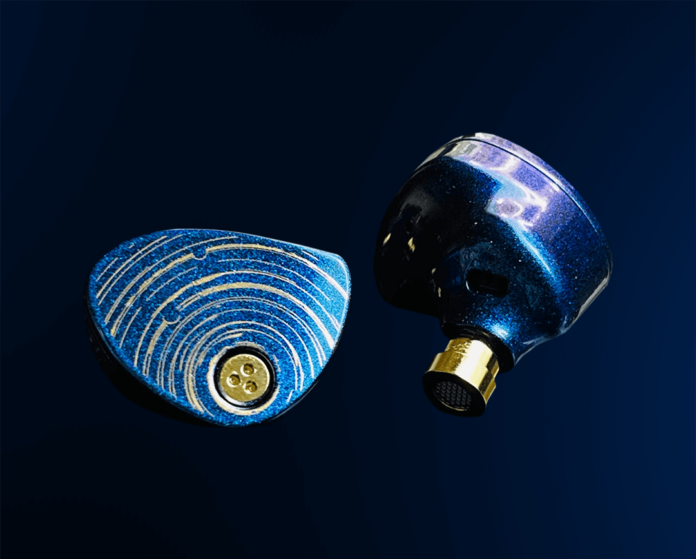Moondrop is all the rage these days, appealing especially to audiophiles on a budget. The $320 Moondrop Blessing 3, for example, might be of the most impressive performers on the market for the price. It’s also one of their best-selling models. So, I was curious to see what the Company could do for around one hundred bucks with their second iteration of the Starfield, the Starfield 2. What can you expect in terms of sound signature and design? And does the Starfield 2 over-perform of the price?
What’s in the Box?
- Moondrop Starfield 2 IEMs
- Silver coated 2-pin cable with 3.5mm plug
- Nozzle filters
- 3 sets of silicone ear tips (S,M,L)
- Small hard carrying case
- User guide
- Warranty card
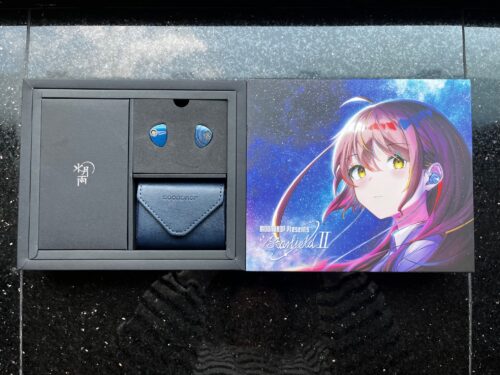
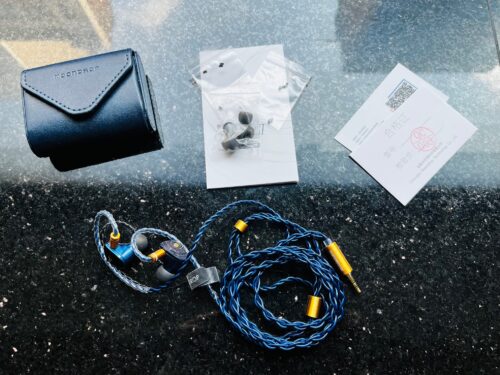
Look and Feel
Right out of the box, the Starfield 2 doesn’t feel like a $100 IEM. It’s weighty and very solid in my hands, clearly veering away from the lighter and more glitzy bulbous shells that have saturated the market. In fact, to me, the shells are more reminiscent of something from the 64 Audio line-up. The housing is made from CNC-milled Cast alloy, and paired with the slightly shimmery blue coating, the design comes across as tasteful and high-end. The gold engraving also adds touch of brilliance, complementing the deep blue tone.
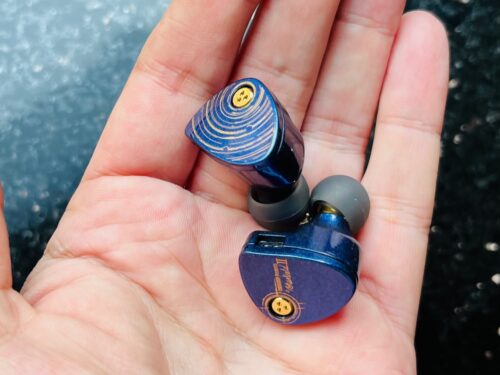
I rarely run into issues with comfort, and such was mainly the case with the Starfield 2. That being said, the over-ear wire started to get a little uncomfortable on one side after extended wear. This could have been caused by my glasses, so, my four-eyed friends may need to adjust the wire here and there to get the most comfortable fit. Other than that, the shells fits perfectly to the contours of my ears and felt well sealed with effective sound isolation.
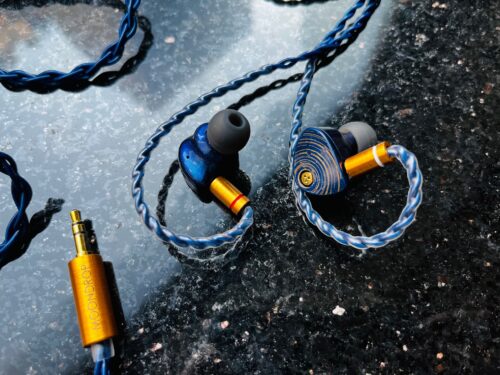
Design
The Starfield 2 uses a 10mm dynamic driver, employing a lithium-magnesium alloy dome diaphragm, which according to Moondrop, beats the performance of pure beryllium domes and does a better job of reducing resonance. It also comes with Moondrop’s new custom silver-plated 2-pin cable with 3.5mm termination (packaged in blue to complement the shells). The removable tip at the front end of the brass nozzle allows you replace the filters to adjust the sound signature. But to be honest, these filters are so tiny, that you might less inclined to tinker around with them. Personally, I just couldn’t be bothered, and I wanted to hear what these IEMs were intended to sound right out of the box.
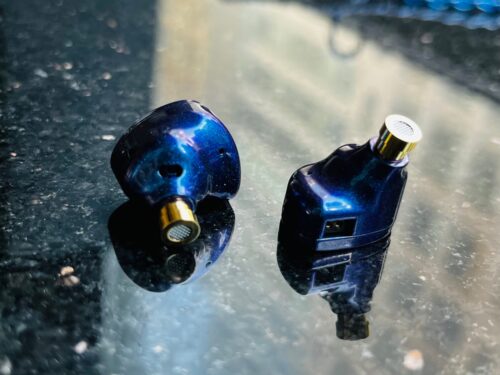
The Starfield 2 is quite efficient. So, it’s easy to drive, and you should get plenty of headroom even when connected to your phone. But for this review, I paired the IEMs with my little Astell & Kern SR35.
Specifications
Frequency Response: 12Hz-24KHz
Sensitivity: 122dB
lmpedance: 15 Ohms
Sound Impressions
Soundstage
The Starfield’s soundstage is easily one of its standout features. The stage feels grand without veering into exaggeration. It’s especially expansive in width, and delivers impressive nuance with respect to instrument placement. The generous distancing between instruments is particularly notable, playing a major role in the overall sense of dimension. The presentation of depth is perhaps less astonishing, as instruments mixed to be positioned solidly behind the ears, sometimes drift into the stereo field. Still, the forward placement feels pretty obvious, and though you may not hear instruments reaching soaring heights, you’ll hear plenty of variation along the vertical axis. Certainly, the Starfield 2’s admirably multidimensional imaging creates a super engaging and colorful sonic landscape that complements its vibrant tuning.
Low-End
The Starfield packs some serious punch in the sub-frequency range, and you can feel the rumble in your chest. But what surprised me was that despite the power, the bass doesn’t become overly thick and heavy-handed. It satisfied my bass craving without going full-on bass-head mode. In fact, personally I think the bass tuning is spot on, always doing its job without encroaching on the territory of higher frequencies. Moving up the low-end, the bass response becomes a touch more moderate. But the transition is smooth. And what’s particularly impressive here is the speedy transient response. It’s as tight as it is quick, injecting loads of energy and funk into modern tracks.
Mids
The mids feel highly dynamic, with a tilt towards the upper midrange and lower treble. This tuning creates a somewhat v-shaped sound signature. As a result, vocals and instruments in the higher midrange, like guitars and snares, really pop out, bringing a lively and energetic character to the sound profile. It’s crisp and snappy, adding excitement to the delivery. Vocals, in particular, shine with a vivid and glowing quality. But, here’s the flip side – the lower midrange takes a bit of a step back. As a result, you may be left hungry for a little more body and lushness. That being said, the warmth in the low-end compensates for some of that. It’s worth noting that sometimes, the pronounced upper-mids can tread the line of being slightly harsh, especially with tracks heavy on vocals. But if you’re into a highly animated sound, this midrange balance is ideal.
Clarity and separation are particularly impressive in this range. The clean definition of singular instruments, as well as the tidy delineation between all of the musical elements (even in the potentially muddy low-mid frequencies) is striking for this price point. And again, the fantastic speed and tightness of the sound signature contribute to a presentation that’s both immaculate and powerful.
High-End
Moving on to the high frequencies, there’s a lower treble boost that extends from the upper-midrange prominence. Despite this, the highest frequencies demonstrate a gentle roll-off, steering clear of any unpleasant sharpness. The highs feel buoyant enough, though the vocals may not be particularly airy. Acoustic instruments enjoy a decent level of transparency, although, at times, the more subtle details felt a touch smoothed over. And overall, there’s a very mild coloration to the sound, which makes strings, woodwinds, and brass in this range feel slightly “touched” rather than entirely natural. However, this somewhat refined quality adds to smoothness of the sound, resulting in a pleasing and fatigue-free listening experience.
Final Verdict
If you enjoy a relatively v-shaped sound signature, the Moondrop Starfield 2 amply delivers the energy, snap, and tightness that complements this type of tuning. But if you’re like me and lean towards a more comprehensive, meatier sound, you might find yourself yearning for a bit more body. That said, if you’re willing to trade some heft for vivacity, the Starfield 2 offers a seriously entertaining listening experience. And of course, the commendable soundstage and precise, colorful imaging adds an extra layer of vibrancy to the overall sonic picture. The Starfield 2 might not be the most uniquely distinctive sound in a market filled with similarly tuned IEMs. However, in terms of performance, it unquestionably justifies its price tag. And as an entry point into the audiophile world, it’s certainly a worthy contender.
Moondrop Starfield 2
|
Pros |
Cons |
| Entertaining soundstage | Vocals can be a tad grating on certain tracks |
| Spotless presentation | |
| Great transient response | |
| Well-priced | |
| High quality build |
You can buy the Moondrop Starfield 2 at Audio 46.
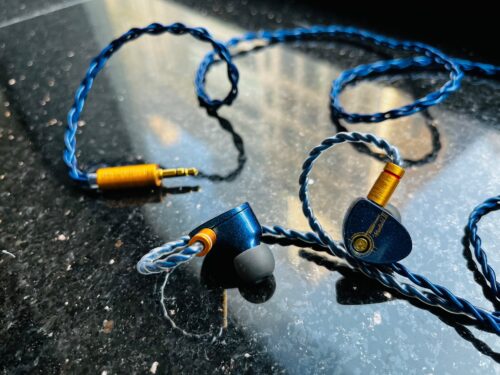
MAJORHIFI may receive commissions from retail offers.


